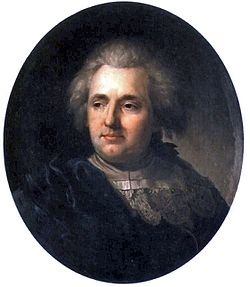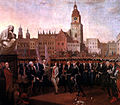Kaaveh Ahangar~enwiki (talk | contribs) mNo edit summary |
Kaaveh Ahangar~enwiki (talk | contribs) mNo edit summary |
||
| Line 13: | Line 13: | ||
<gallery> |
<gallery> |
||
Image:Smuglewicz-Posłowie scytyjscy przed Dariuszem.jpg| ''Scythians meeting with [[Darius]]'', 1785 |
Image:Smuglewicz-Posłowie scytyjscy przed Dariuszem.jpg| ''Scythians meeting with [[Darius I of Persia|Darius]]'', 1785 |
||
Image:Portrait of Prozor Family.jpg|Portrait of the Prozor Family, 1789, National Museum in [[Warsaw]] |
Image:Portrait of Prozor Family.jpg|Portrait of the Prozor Family, 1789, National Museum in [[Warsaw]] |
||
Image:Smuglewicz Kosciuszko.jpg|"[[Tadeusz Kosciuszko|Tadeusz Kościuszko]] taking the oath", 1797 |
Image:Smuglewicz Kosciuszko.jpg|"[[Tadeusz Kosciuszko|Tadeusz Kościuszko]] taking the oath", 1797 |
||
Revision as of 00:59, 30 June 2008

Franciszek Smuglewicz (spelled in Lithuanian as Pranciškus Smuglevičius) (1745-1807) was a Polish draughtsman and painter. Brother of Antoni, he is considered the first Polish historical painter and, to certain extent, a spiritual father of Jan Matejko's school.
Smuglewicz was born October 6, 1745 in Warsaw, Poland. In 1763 he moved to Rome, where he started studies of fine arts under tutorship of Anton von Maron. In 1765 he received a royal scholarship of king Stanisław August Poniatowski and was admitted to the Saint Lucas Academy. As a collaborator of Vincenzo Brenna he has participated in inventarisation of Nero`s Domus Aurea. In 1784 he returned to his native Warsaw, where he founded his own school of fine arts, one of the predecessors of the modern Academy of Fine Arts.
A classicist, but under strong influence of the Polish baroque, Smuglewicz became the first Polish representative of historical painting, a notion that dominated the fine arts of Poland throughout the 19th century. Around 1790 he started working on a series of sketches and lithographies inspired by Adam Naruszewicz's History of the Polish Nation. Although never finished, the seried gained him much popularity.
In 1797 he moved to Vilnius, where he became the founder and the first deacon of the Institute of Sketch and Painting at the Academy of Vilna . A tutor of several generations of Polish-Lithuanian painters, Smuglewicz devoted himself to historical painting in the latter years of his life. Among the notable surviving works of that period are A Meeting of the Four Years' Sejm (1793) and Kościuszko's Oath at Kraków's Old Town Market (1797). He also painted a series of depictions of contemporary views of the city. Among his works of the period are priceless views of the city walls and city gates, demolished in 19th century. His works have profound importance for the ongoing reconstruction of the Royal Palace of Lithuania, as being the only reliable source to meticulously present their authentic features.
He died September 18, 1807 and was buried at the Rasos Cemetery, although his grave remains unknown.
-
Scythians meeting with Darius, 1785
-
Portrait of the Prozor Family, 1789, National Museum in Warsaw
-
"Tadeusz Kościuszko taking the oath", 1797


